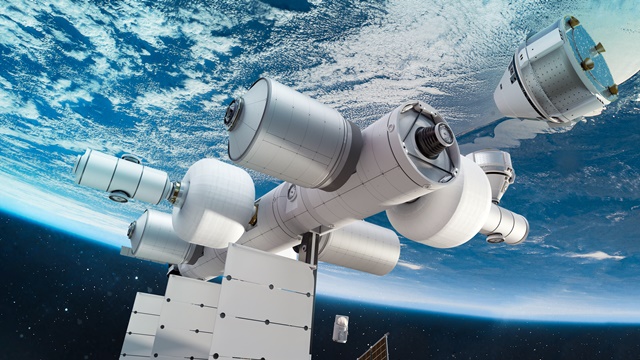29 Sept. 2022. A collaboration between university researchers and a space science company is designing a stem cell research lab on a proposed commercial space station. The partnership between Sierra Space in Louisville, Colorado and the Sanford Stem Cell Clinical Center at University of California in San Diego expands on the university’s current studies of stem cell development in microgravity.
Sierra Space is one of the lead developers of Orbital Reef, a commercial space station designed for low-Earth orbit that aims to offer a business park for space-based commerce, research, and tourism. Blue Origin, the other lead developer for Orbital Reef, is providing reusable launch vehicles for the project, while Sierra Space provides its habitation modules and Dream Chaser space plane, a winged spacecraft similar to the NASA space shuttle. Orbital Reef is expected to become operational in 2027, orbit 500 kilometers (311 miles) above the Earth, and accommodate up to 10 people in living space comparable to the International Space Station.
The Sanford center at UC San Diego studies treatments for regenerative medicine with stem cells, including clinical trials of stem cell therapies. In April 2020, the Sanford center began a collaboration with the company Space Tango to begin studies of stem cell development in microgravity on the International Space Station or ISS. That project became the Integrated Space Stem Cell Orbital Research, or ISSCOR, funded by a $5 million NASA grant. As reported by Science & Enterprise at the time, the UC San Diego researchers are designing experiments to be conducted in weightless conditions on stem cells derived from blood and immune-system cells, looking for changes in biomarkers indicating cellular malfunctions associated with cancer.
Research labs and biomanufacturing
“Microgravity and radiation exposure in low-Earth orbit,” says Catriona Jamieson, director of the Sanford center in a Sierra Space statement, “offers a unique opportunity to study stem cell aging and pre-cancer development in a compressed time frame in a manner that is unavailable on Earth.” Jamieson adds, “We are learning things that we never could under normal gravity; knowledge that can elevate the search for new pre-cancer diagnostics and therapeutics that eradicate cancer at its earliest stages into addition to a broad array of degenerative diseases that arise as a result of stem cell dysfunction.”
Under the new agreement, Sierra Space and the Sanford center are collaborating on extending the ISSCOR labs into Orbital Reef. A UC San Diego team is contributing design and operational planning expertise for stem cell research labs, as well as biomanufacturing and fabrication on the new space station. The university is also taking part in a biomanufacturing research consortium led by Sierra Space, for advice on R&D objectives and technical requirements. Sierra Space is responsible for development of the labs and biomanufacturing facilities, as well as their launch and deployment.
“As the ISS completes its time in service,” notes Sierra Space CEO Tom Vice, “UC San Diego will now have a place to grow and expand its vital research in biotech and biopharma with full, on-orbit biomanufacturing and biofabrication centers to foster breakthrough advancements and products in medical science that will benefit all life on Earth.”
More from Science & Enterprise:
- Infographic – Earth Orbits Getting More Crowded
- NASA Supporting Electric Alternative to Rocket Launch
- New Industry, Academic Studies Arrive at Space Station
- Consortium to Build Commercial Space Station
- Small Biz Award Funds Space Travel Refrigerator
We designed Science & Enterprise for busy readers including investors, researchers, entrepreneurs, and students. Except for a narrow cookies and privacy strip for first-time visitors, we have no pop-ups blocking the entire page, nor distracting animated GIF graphics. If you want to subscribe for daily email alerts, you can do that here, or find the link in the upper left-hand corner of the desktop page. The site is free, with no paywall. But, of course, donations are gratefully accepted.
* * *


 RSS - Posts
RSS - Posts
You must be logged in to post a comment.